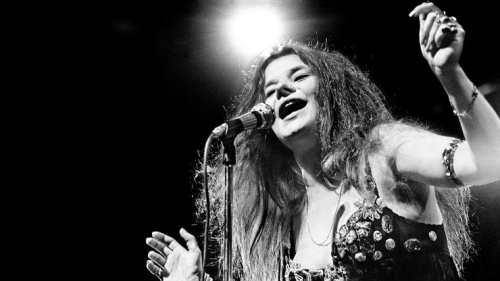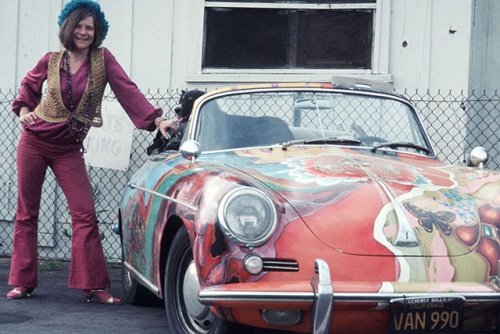By Gary:
I have been avoiding this Artist for some time. She had a very troubled life, her self esteem was terrible, but her voice was to die for, but we only had her for a very short time (27 years). I just watched the American Masters PBS presentation of “Little Girl Blue”, it was great and depressing. Her last real Canadian Connection was the Full Tilt Boogie Band, which probably was the best band she ever had. Let’s take a look at one of the true great blues singers of my era


Janis Joplin
(1943 – 1970)
Videos:
1970 / her last year / Cry Baby / Toronto with the Full Tilt Boogie Band /
.
1969 / Dick Cavett Show / To Love Somebody /
.
1968 / Germany / Piece of my Heart /
.
1967 / Monterey Pop / Ball & Chain (before she was famous) /
.
Music:
Her success was mainly in albums
These are the successful singles
1968 / Down on Me / # 43 BB
.
1968 / Piece of My Heart / # 12 BB
.
1969 / Kozmic Blues / # 41 BB
.
1971 / Me and Bobbie McGee / # 1 BB
.
1971 / Cry Baby / # 42 BB
.
Janis Joplin grew up in a small Texas town known for its connections to the oil industry with a skyline dotted with oil tanks and oil refineries. For years, Joplin struggled to escape from this confining community and spent even longer to trying to overcome her memories of her difficult years there.
Developing a love for music at an early age, Joplin sang in her church choir as a child and showed some promise as a performer. She was an only child until the age of 6 when her sister Laura was born. Four years later, her brother Michael arrived. Joplin was a good student and fairly popular until around the age of 14 when some side effects of puberty started to kick in. She got acne and gained some weight.
At Thomas Jefferson High School, Joplin started to rebel. She eschewed the popular girls’ fashions of the late 1950s, often choosing to wear men’s shirts and tights or short skirts. While she liked to stand out from the crowd, Joplin also found herself the target of some teasing and a popular subject in the school’s rumour mill. She was called a “pig” by some while others said that she was sexually promiscuous.
Joplin eventually developed a group of guy friends who shared her interest in music and the Beat Generation, which emphasized creative expression, rejecting the standard norms . Jack Kerouac and Allen Ginsberg were two of the leading figures in that movement.
Musically, Joplin and her friends gravitated toward blues and jazz music, admiring such artists as Leadbelly. She also was inspired by legendary blues vocalists Bessie Smith and Ma Rainey and Odetta, an early leading figure in the folk music movement. The group also frequented local working-class bars in the nearby Louisiana of Vinton. By her senior year of high school, Joplin had developed a persona of sorts, a ballsy, tough-talking girl who liked to drink and be outrageous.
After graduating high school, Joplin enrolled at Lamar State College of Technology in the neighbouring town of Beaumont. There she spent more time hanging out and drinking than on her studies. At the end of the semester, Joplin left school. She took some secretarial courses at Port Arthur College and moved to Los Angeles in the summer of 1961. This first effort to break away from home failed, and she returned to Port Arthur and her studies at Lamar for a time.
In 1962, Joplin left again to study at the University of Texas at Austin. There she started performing at Folksongs casual musical gatherings where anyone can perform on campus and at a local club with the Waller Creek Boys, a musical trio she was friends with. With her forceful, gutsy singing style, Joplin amazed many audience members. She was unlike any other white female vocalist at the time – folk icons Joan Baez and Judy Collins were known for their gentle sound.
In January 1963, Joplin ditched school to check out the emerging music scene in San Francisco with friend Chet Helms. During this first stint in San Francisco, Joplin struggled to make it as a singer. She played some gigs, including a side stage at the 1963 Monterey Folk Festival but her career never really got off the ground. She went to New York City for a time, hoping to have better luck there, but her drinking and drug use got in the way. Joplin eventually developed a nasty speed habit and left San Francisco to return home in 1965 to get herself together again.
Terrified from her ordeal, Joplin took a break from her music and her hard partying lifestyle. She dressed conservatively, put her long, often messy hair into a bun, and did everything else she could to appear straight-laced. But the conventional life was not for her, and her desire to pursue her musical dreams could not stay submerged for long. Joplin slowly returned to performing and was recruited by friend Travis Rivers to join a San Francisco psychedelic rock band called Big Brother and the Holding Company, which was managed by another long-time friend Chet Helms at the time.
In 1966, Joplin returned to San Francisco to audition for Big Brother, which consisted of James Gurley, Dave Getz, Peter Albin, and Sam Andrew. The group was part of the burgeoning San Francisco music scene of the late 1960s, which also included such bands as the Grateful Dead. They were impressed with Joplin and wanted her to join the group. In her early days with Big Brother, she only sang a few songs and played the tambourine in the background.
It was not long before Joplin assumed a bigger role in Big Brother as the group developed quite a following in the San Francisco area. Their appearance at the now legendary Monterey Pop Festival in 1967 brought them wider acclaim, especially their version of “Ball and Chain” (which was originally made famous by R&B legend Big Mama Thornton). Most of the praise, however, focused on Joplin’s incredible vocals. All of this attention caused some tension between Joplin and the rest of the band.
After hearing Joplin at Monterey, president of Columbia Records Clive Davis wanted to sign the band. Albert Grossman who already managed Bob Dylan, the Band, and Peter, Paul and Mary later signed on as the band’s manager and was able to get them out of another record deal that they had signed earlier with Mainstream Records.
While their recordings for Mainstream never really went anywhere, their first album for Columbia was a huge hit. The wildly successful Cheap Thrills (1968) was a challenge to make and caused even more problems between Joplin and her band mates. John Simon served as the producer on the project and had the band do take after take trying to get songs down technically perfect. The band, however, was used to playing live in a sloppy style. Joplin reportedly felt like the group was beginning to hold her back professionally. Soon after its August 1968 release, the album was a certified gold record. It featured “Piece of My Heart” and “Summertime.” These songs helped cement Joplin’s reputation as a unique and dynamic bluesy rock singer. The cover for the album had been designed by famed underground cartoonist R. Crumb.
Joplin struggled with her decision to leave Big Brother because they had been like a family to her for a time. But she eventually decided to break with the band and go her own way. Joplin played with Big Brother for the last time in December 1968.
Joplin’s first solo effort, ‘I Got Dem Ol’ Kozmic Blues Again Mama!’ (1969), with Kozmic Blues Band, received mixed reviews. Some of the recording’s most memorable songs were “Try (Just a Little Bit Harder)” and “To Love Somebody,” a cover of a Bee Gees’ tune. Outside of music, Joplin appeared to be struggling with alcohol and drugs, including an addiction to heroin.
Unfortunately, Joplin’s next album would be her most successful, but also her last. She recorded Pearl with the Full Tilt Boogie Band and wrote two of its songs, the powerful, rocking “Move Over” and “Mercedes Benz,” a gospel-styled send-up of consumerism.
After a long struggle with substance abuse, Joplin died from an accidental heroin overdose on October 4, 1970, at a hotel in Hollywood.
Completed by Joplin’s producer, Pearl was released the next year and quickly became a hit. The single “Me and Bobby McGee,” which was written by Kris Kristofferson, reached the top of the charts.
Despite her untimely death, Joplin’s songs continue to win new fans and inspire other performers. Numerous collections of her songs have been released over the years, including ‘In Concert’ (1971) and ‘Box of Pearls’ (1999). In recognition of her significant accomplishments, she was inducted into the Rock and Roll Hall of Fame in 1995 and received a posthumous Recording Academy Lifetime Achievement Award at the Grammy Awards in 2005.
Janis Joplin’s life has been the subject of many books and documentaries, including ‘Love, Janis’ (1992) written by her sister Laura Joplin. That book has been turned into a play by the same title.
–o–


Gary:
Could you please find an actual Bobbie McGee video with her performing the song. This is the best one I could find, but she is not performing, on all others where she is performing she is not herself, to put it bluntly.
Would love to see a good sober video of this song because of all artists she sang it the best.
All said and done what a shameful waste of a talent.
Wally the Marshal
Hi Wally
Here’s the closes thing I could find to an actual LIVE video.
– Russ
Great talent. Self destructive. Sad.
Got to leave another comment. This blog will keep me up half the night replaying these great cuts. Rock on Janis !
The complete video ‘Janis: Little Girl Blue’ is available for streaming on Netflix. I was never a fan of her music but the documentary is worth watching.
Thanks, Les! Will check it out.